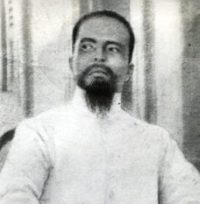It was a beautiful day, Saturday, February 4, 1899.[1] There was peace and happiness everywhere in Malolos because on this day the (peace) Commissioners were to read before Congress the results of the conferences held with the American emissaries of McKinley to reach an agreement between the two nations. Happiness, because the Filipino nation had high hopes that at the end of the conference an agreement favorable to the aspirations of our people would be reached.
In the afternoon, Congress began its session; a numerous public invaded the temple of laws to listen to the outcome of the conferences. Almost all the representatives were at their posts. The session began. Gracio Gonzaga, Secretary of Fomento, representing our government, read the results of the conferences held with the American envoys headed by Schurman,[2] and the Filipinos headed by Florentino Torres.
It was clear that the envoys of the Imperialist Party were not invested with the powers needed to pass any resolution; thus, messages were telegraphed to the McKinley cabinet. In short, nothing was accomplished during the conferences except wasting our time and dampening the spirit of our people.
Coincidence, fatality, Machiavellian stratagem, or concerted action between the American Army and their envoys—the truth is that on that same day, Saturday, February 4, the last groups of soldiers sent by McKinley disembarked at the plains of Santa Mesa with their cannons facing San Juan del Monte, where the advance forces of the Filipinos were stationed. On that day, the talks were terminated without coming to any agreement. Our fears did not take long to come to a head.
The evening was quiet with a silver moon shining; Malolos was happy; a dance was being held in the house of Mrs. Concha del Rosario, widow of Mapúa. Gen. Artemio Ricarte and Col. Luciano San Miguel, commanders of the Santa Ana line in Manila, were paying homage to Terpsichore. While Malolos was in deep slumber without any suspicion of an unrest, between midnight and 1 o’clock in the morning, an unusual noise woke the unsuspecting inhabitants. The cry of “War” reverberated everywhere. The hostilities had begun!
We woke up at 1 o’clock and went to the Central Postal Station, where we met the Honorable President of the Philippine Republic issuing orders. All the prominent members of the government were also there: Gen. Ricarte, Col. San Miguel, [Teodoro] Sandico, and others.
About 3 o’clock, Gen. Ricarte and Col. San Miguel boarded a train for Sta. Ana; Moreno and I accompanied them. At 5 a.m. we reached the station at Caloocan and continued on foot to Maypajo. Before reaching it, Ricarte and San Miguel separated from our group and took the road to La Loma; Moreno and I proceeded to the trenches at Maypajo and reached them at 5:30 a.m. Here we learned of the impossibility of reaching Manila; Moreno has been appointed chief of the volunteers from Manila.
After a while some soldiers from detachments in Solis arrived informing us that they were leaving because they had no longer any cartridges. I left Moreno at 6 o’clock to be in Caloocan with the intention of establishing an emergency field hospital while waiting for the military health unit to take some action. A few steps away sounds of guns and cannons rent the air while shots whistled by, instilling in me the fear that the end was near. During intervals, I made my way and reached unscathed the municipal building where I intended to attend to the wounded. I had hardly gone upstairs when I saw a warship in the bay opposite the building. I left for the railroad station; but barely twenty meters away a grenade fell. I entered the station and saw a wounded man, but as I did not have anything with me to help him, and knowing the impossibility of requesting medicines from Malabon, I departed and took the train for Malolos.
When I arrived home, Choling[3] told me that I was a coward because I had abandoned the fighting. I explained to her that I had come to get bandages and medicines because there were none there. I went to the drug store and requested everything needed for first aid. When I inquired for the cost, the pharmacist refused to collect. At 1 in the afternoon of the 5th, after lunch, I returned to Caloocan bringing my surgery satchel. I found [Antonio] Luna, José, [Leon Ma.] Guerrero and [Anastacio] Francisco, Inspector General of Military Health.
At 4 p.m. a stretcher arrived bringing [José] Torres Bugallon, Major of the General Staff, with a broken right thigh; he was very pale, looking almost bloodless owing to profuse hemorrhage. He stretched his hand upon seeing me, relating at the same time how he had been wounded.
He said, “I was leading the troops when I felt I was wounded, but continued marching about fifty meters farther; then I fell. I felt I was being dragged and then I lapsed into unconsciousness. I did not know anything more until I found myself here today. Bitter and endless fighting continued on both sides.” I asked him to stop talking and he kept silent.
Luna and I applied first aid to him then he was transferred to the Lolomboy Hospital at Bocaue. He died, however, on the way. The body was taken to Malolos, where it was buried. I was left in Bocaue, where I intended to establish a hospital; but with the presence of De Jesus and Cordero of the medical corps, I proceeded to Meycauayan, where I spent the night. On the following day, I stayed in the Polo station to attend to the wounded. On the third day, seeing that the medical staff of the military unit had taken complete control of the situation, I returned to Malolos.
[1] Manuscript carries year of 1900.
[2]Jacob Gould Schurman.
[3]Consuelo de Santos, youngest daughter of Marcelino de Santos; Barcelona married her on July 6, 1901.
